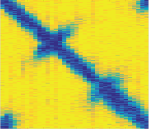
At any given moment, our retinas receive millions of bits of information. This presents a monumental computational challenge to the visual system. Rather than process everything our sensory systems receive, we rely on heuristics to reduce computational load. My research centers around one such critical heuristic: ensemble perception, which refers to the idea that we can represent sets of objects using summary statistics. Instead of seeing every single leaf on a tree, we tend to see its overall ‘leafiness.’ It turns out that we engage this process even when we see crowds of faces. We rapidly derive the average emotion of the crowd, but not the individuals. Ensemble perception makes great intuitive sense — The visual system exploits the natural redundancy present in the world (e.g., most leaves are quite similar), which allows us to elegantly represent a vast amount of information.
Projects (click on thumbnail for more info):
Ensemble Perception
Individual differences in ensemble perception

Conceptual ensemble representations

Social Cognition
Recent work takes a more applied approach. We are investigating a range of topics, including the perception of social status, representation of self, and prosthetic limb size. These efforts reflect burgeoning collaborations and the varied interests of my talented undergraduate research students.
The influence of perceived gender on emotion perception









